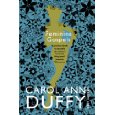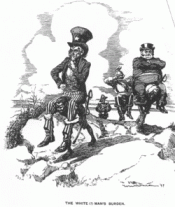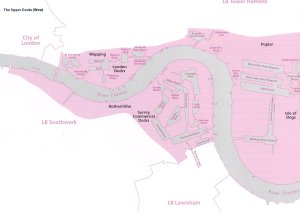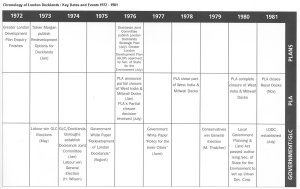




 Since Mary Wollstonecraft’s A Vindication of the Rights of Women was first published, feminism has played a major role in British Literature. Although Wollstonecraft was not the first feminist writer, she was definitely the most influential. Her works transcended the definitions of equality and liberation. She criticized ideas in Great Britain that were part of the society of the time. Such ideas that were discussed in her work focus on: the degradation and subservience of women within the domestic spheres (i.e., the household); a confining values system towards women within the patriarchal society that was based on thousands of years of tradition of said values (such values that condemned the sexual, marital, and consensual rights of women); a male-dominated educational system; the stereotypes that have dominated the portrayals of womankind throughout history; The physically and emotionally abusive treatment that women endure in both their private and public spheres; and lastly inequality, in terms of women’s suffrage. She took a stand against the British and as well the French patriarchy that was growing more powerful than ever. Wollstonecraft’s works would become highly influential for her contemporaries who would follow a couple of centuries later.
Since Mary Wollstonecraft’s A Vindication of the Rights of Women was first published, feminism has played a major role in British Literature. Although Wollstonecraft was not the first feminist writer, she was definitely the most influential. Her works transcended the definitions of equality and liberation. She criticized ideas in Great Britain that were part of the society of the time. Such ideas that were discussed in her work focus on: the degradation and subservience of women within the domestic spheres (i.e., the household); a confining values system towards women within the patriarchal society that was based on thousands of years of tradition of said values (such values that condemned the sexual, marital, and consensual rights of women); a male-dominated educational system; the stereotypes that have dominated the portrayals of womankind throughout history; The physically and emotionally abusive treatment that women endure in both their private and public spheres; and lastly inequality, in terms of women’s suffrage. She took a stand against the British and as well the French patriarchy that was growing more powerful than ever. Wollstonecraft’s works would become highly influential for her contemporaries who would follow a couple of centuries later.
However, as much as she was ahead of her time, it was her contemporaries, the writers I had the opportunity to study throughout my experience in England, who took these issues that brought about by Mary Wollstonecraft, to a whole other level. Throughout this piece, I will be sharing my thoughts, but at the same time analyzing the relevance on six major works and archives that represent the more modern ideas that helped shape feminism. I will also show how each of these works relate to the six key issues that were first brought up by the legendary feminist, Mary Wollstonecraft. These works showed how feminism was viewed then as well as how it is viewed today. As well they all give us different perspectives but at the same time make the same point clear and that is women’s rights and equality and realizing the struggles that these women went through in order to express and convey these messages. Tracy Chevalier’s Falling Angels, Bernardine Evaristo’s The Emperor’s Babe, Virginia Woolf’s Professions for Women, Carol Ann Duffy’s Feminine Gospels, Patience Agbabi’s Bloodshot Monochrome, and the Suffragettes’ exhibit at the Museum of London. These works and archives do a great job at exemplifying the different socio-cultural aspects that define feminism.
The first work that I would like to discuss is Carol Ann Duffy’s selected collection of prose and poetry, “Feminine Gospels.” I feel out of all the poems in this work, it is the 20-page narrative, The Laughter of Stafford Girls’ High that conveys my first topic; women in education. It does an excellent job at exploiting the problems with the masculine society that dominated every aspect of the British education system during this time period the poem is set (the early 1960s). Throughout this poem, we can see that women in the education system at this time weren’t really taught how to read as much or write as much but a lot of their education was centered on “lady-like” etiquette. In other words, what a young lady should be, how a young lady should act and how a young shouldn’t act. In that sense all they were learning was how to be a house-wife instead of being a doctor; or a lawyer; or a college professor; no all they were taught was how to be a homemaker. And don’t get me wrong, I am sure there are women who work hard to take care of everything around their home and choose to be with and care for their families and I do not mean any disrespect towards them. The difference in our day and age (at least in the western world) is that women have more of a choice. During the time this poem takes place in, this was definitely not the case. It was sickening to know that these young ladies were not really students in the sense of future scholars but in the sense of future homemakers.
However, the poem also presents a great deal of hope for women in education through two of its most vital characters, Geraldine and Miss Dunn. Geraldine is portrayed as this free-spirited yet somewhat rebellious student who protests the educational system she is under by encouraging this infectious laughter that is tearing this school apart. And then there is Miss Dunn who, like the rest of the teachers in this piece, was trying to assimilate her students to this life under what I call the “homemaker-label” (i.e., the molding of a young lady into the assimilated stereotype of a house-wife of that time period and/or prior). In actuality, Miss Dunn is shamed by the society around her for not being married due to “the moral standard” that a woman must follow. But, towards the end of this poem, Miss Dunn comes to this self-realization that there is more to womanhood than just staying the home and pleasing and caring for one’s man, but exploring the world outside of the socio-domestic constructs that make up this atmosphere. This piece represents the need to break free from this oppressive sphere of education.
My next topic, the degradation and subservience of women within the domestic spheres, will focus on Virginia Woolf’s essay “Professions for Women.” This was part of Woolf’s Seven Essay article in Vanity Fair in which she criticizes Coventry Patmore’s The Angel in the House and his portrayal of the “perfect woman.” The essay goes in depth on how when women write they provide themselves a great opportunity to “killing the angel in the house” (metaphorically speaking). This refers to women stripping the bonds of their subservient homemaker duties but to go out and make a name for their own livelihoods. I felt Woolf goes into a great deal with this by using her own profession as an established scholarly writer as a way of showing that women can break these foundations.
In this essay, Woolf discusses the topic of opportunities outside of the household for women. She argues that:
“Even when the path is nominally open–when there is nothing to prevent a woman from being a doctor, a lawyer, a civil servant–there are many phantoms and obstacles, as I believe, looming in her way.” (Professions for Women)
According to Woolf, these “obstacles” are not only represented by the male dominated system that these domestic spheres were ruled under, but also by the women who were brainwashed into this form of patriarchal imprisonment. Her message was to free women out of this spectral livelihood of the stereotypical homemaker and become something greater without the pressures from this society ruled by men crashing down on them. The obstacles that stand in the way of opportunities for women haunt the words written in this legendary piece. By preaching to “kill the angel in the house,” she implies this need to break free within women and this need to do more. Its messages like this essay brings that made promote feminism and the individuality of women to their fullest potential.
The third topic that will be discussed covers the confining values system towards women within the patriarchal society that was based on thousands of years of tradition of said values (such values that condemned the sexual, marital, and consensual rights of women). Bernardine Evaristo’s “The Emperor’s Babe” is the best example of these concerning issues. The prose is centered on the Roman-Londinium era in England and shows a more modern, feminist portrayal of the women living in this society during the time. As most know or should know the treatment of women was extremely unjust and oppressive. The women of Londinium, in 211 A.D., lacked education, opportunities of true political power, and self-empowerment. However, the main character in this prose, Zuleika, provides us as readers this “what if” scenario of this empowered, intelligent and rebellious woman. Zuleika moves her way up after her tragic trade-off from her father into her forced marriage with Emperor Septimus Severus. However, she learns and moves her way up to power and becomes the true definition of a “queen bee.” The unique personality that she develops in her experience in the presence of royalty makes her more than just some pretty face but a force to be reckoned with. But as well we see the influence of African roots and the customs and values that they showed towards the women in their culture. Being the daughter of Sudanese immigrants in Londinium at the time we can see how nonchalant her father was about selling her to Emperor Severus.
However, her wit does get her far. Another aspect of the self that gets her far is her rebellious opinions against the traditional yet absurd etiquette that women were forcibly assimilated to. An example of this is shown when Zuleika narrates:
“A lady uses powdered horn to enamel her teeth dontcha know, and powdered mouse brains to keep her breath sweet. I am pampered by maids, an ornatrix is weaving Indian hair into my own, six pads- Vestal- style. They are painting me white with chalk, my lips and cheeks with the lees of red wine, don’t talk! Black ash is dabbed onto my eyes.” (27)
This implies two different feelings that Zuleika has at this time; feelings of happiness at the fact that she is living the life of royalty, yet at the same time feelings of defiant discontent towards the lifestyle she leads while her people are suffering. Her sassy, lively attitudes are I feel what drive us to her character and how she took the inhumane action of being sold into a marital relationship by her own father and turned it around into her own move into power.
The fourth topic I will talk about will be on the physically and emotionally abusive treatment that women endured in both their private and public spheres. The work that I felt represents this topic the best is Tracy Chevalier’s “Falling Angels” as the source for this topic. To be honest, I could talk about the fact that the novel takes place and is focused on the early years of the Suffragettes’ Movement in England at the turn of the century, but there were other feminist issues that were focused in this novel. When I read it I felt that this topic on this form of abuse made its presence heavily felt in this novel. To be honest, I thought that the situations and the characters involved in them, conveyed just as much of the verbal and physical abuse towards the women during the time period of this novel, as the issues concerning the Suffragettes’ Movement.
For example, on pages 71-72, when Lavinia’s younger sister Ivy May, an innocent young lady, is raped by Mr. Jackson, to many of us (at least in a western society) we find these actions to be disgusting and psychotic but in the early 20th century, it was acceptable to do such despicable actions in this patriarchal mad house. Even though this was not the most detailed literary depiction out of everything we have read, this was definitely one of the most graphic in my opinion, because just the slightest hint of rape; the subservience that Ivy May shows afterwards; and the acceptance we see towards Mr. Jackson’s actions is highly disturbing.
The fifth topic, the stereotypes that have dominated the portrayals of womankind throughout history, is greatly demonstrated in Patience Agbabi’s “Bloodshot Monochrome.” Due to how important the theme of cultural awareness is in this work by Agbabi, a feminist outlook is conveyed in some of these poems within this work. This feminist outlook in some of these poems could be Agbabi’s way of showing her appreciation for the male and female poets who paved the way her. However, she expresses this assertive language as a form of retaliation and rejection towards the patriarchal oppression that kept the women writers that influenced her confined in both their greater capabilities as writers and as equal individuals in their societies.
In Agbabi’s work we don’t see the stereotypical “damsel in distress;” an evil witch; a woman who is looking to seduce her next male victim; an uneducated ditz; nor a homemaker (or as W.M. Thackeray called it, as I already went over, “the angel in the house”). Instead we are exposed to an incredibly different view of women within this work. There are a few examples that I could point out that can be found in this work. However, the example that I thought best fits this breaking of stereotypes the best, is found in the poem “Josephine Baker Finds Herself.” The poem mainly points out something that has become fairly new to British literature. And that is the perspective of homosexuality; specifically this poem focuses on a lesbian couple and how they use their sense of togetherness to get them through whatever struggles they may be going through. This outlook on a woman’s sexual orientation is definitely an example of Agbabi breaking the boundaries of the patriarchal stereotypes of women. However, there was another poem in this work which contradicts this different viewpoint of womankind.
This was when I began reading the sonnet “Vicious Circle.” In this piece, it went back to this stereotypical portrayal of a woman in England. And at first we see a man who is truly in love with this woman, who not only does not feel the same but by more modern terms, could be assumed as a “gold-digger” (i.e., a woman who uses guys for their money by promising love and faithfulness). However, one can start to see a change in him when his love turns into an obsession. The result of this obsessive behavior left me, the reader with these last lines courtesy of this woman:
“He’s walking towards me. I can hear her crying. I struggle to wake up but can’t quite. The last thing I see before I die, the vicious gaze of his gun’s eye in a basement bar. Black. And white.” (72)
To me it seemed like this woman was scared for her life and we can see this clearly in the narrative, something one would not expect Agbabi to write about. So not only do we see a woman portrayed as this person of wicked intentions but we also see it lead to her demise. This portrayal goes back with the traditions of the patriarchy.
My final topic that will be discussed was inequality, in terms of Women’s suffrage. I specifically turn to the archives of the Suffragettes’ Movement which I had the honor to view in person as they were exhibited at the Museum of London. And that is when I found out about the Women’s Social and Political Union (W.S.P.U.), one of the most important feminist coalitions formed during the time of the Suffragettes’ movement (the early 1900s). Even though Women’s suffrage was not achieved until 1920, the W.S.P.U. still managed to gain a wide amount of support and hold rallies and demonstrations with techniques way ahead of their time. For example, thanks to one of the curators I have the privilege to meet I was able to receive an exclusive look at photos that were not feature in the exhibit. One of the photos that I thought really symbolized that feminist spirit was a photo of one of a controversial suffragette rally that was done in London. It is a photo of these women in what were at the time, very “risky” outfits. They were dressed in nearly skin tight clothing resembling that of Peter Pan. Other information I received from this exhibit was vital to know for the topic of feminism. Such as the infamous leaders of the W.S.P.U. Emmeline Pankhurst who withstood arrests on more than several occasions for the good of her cause and suffered the inhuman acts of forced-feeding during her imprisonments. These women were courageous and revolutionary, especially for the time period they were in. The archives that I witnessed at this museum really opened my mind to a struggle that I was just being introduced to for the first time but it was definitely gave me a greater appreciation for their struggle and greater appreciation for the feminism and its rich history.
In conclusion, this whole experience that I had the privilege and honor to be part of was something will be forever imprinted in my mind. The reason I chose feminism as a topic for my learning analysis was because out of all the different aspects of history that I learned during this trip, the one I took to heart the most was a greater appreciation for the pioneers of feminism, not only within the literary community but as mentioned prior with the suffragettes’ exhibit, in the socio-cultural community too. And even though Mary Wollstonecraft was not covered during the education I received during this experience, her Twentieth Century contemporaries, truly “keep calm and carry on…” the spirit of feminism. Furthermore, it’s these qualities of what me and my fellow students read that really not just for my sake but brought all of us to a greater understanding of feminism.
Works Cited
Agbabi, Patience. Bloodshot Monochrome. London: Canongate, 2008. Print.
Chevalier, Tracy. Falling Angels. London: Penguin, 2001. Print.
Duffy, Carol Ann. Feminine Gospels. London: Faber & Faber, 2002. Print.
Evaristo, Bernardine. The Emperor’s Babe. London: Penguin, 2001. Print.
“Suffragettes’ Exhibit.” Museum of London. 2013. Archive.
Wollstonecraft, Mary. A Vindication of the Rights of Women. Ed. Deidre Shauna Lynch. New York: W.W. Norton & Company, 2009. Print.
Woolf, Virginia. “Professions for Women.” S.Spachman.Tripod.com. Web. 14. Oct. 2013.




























